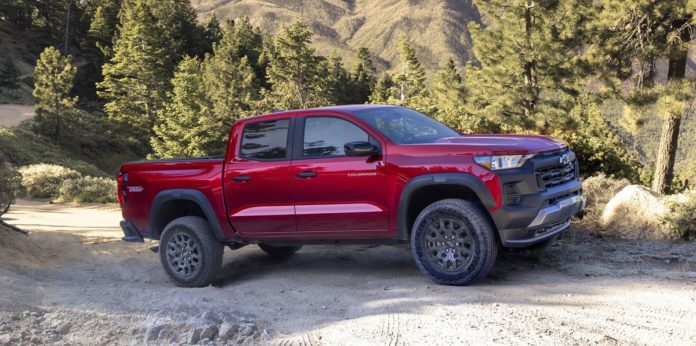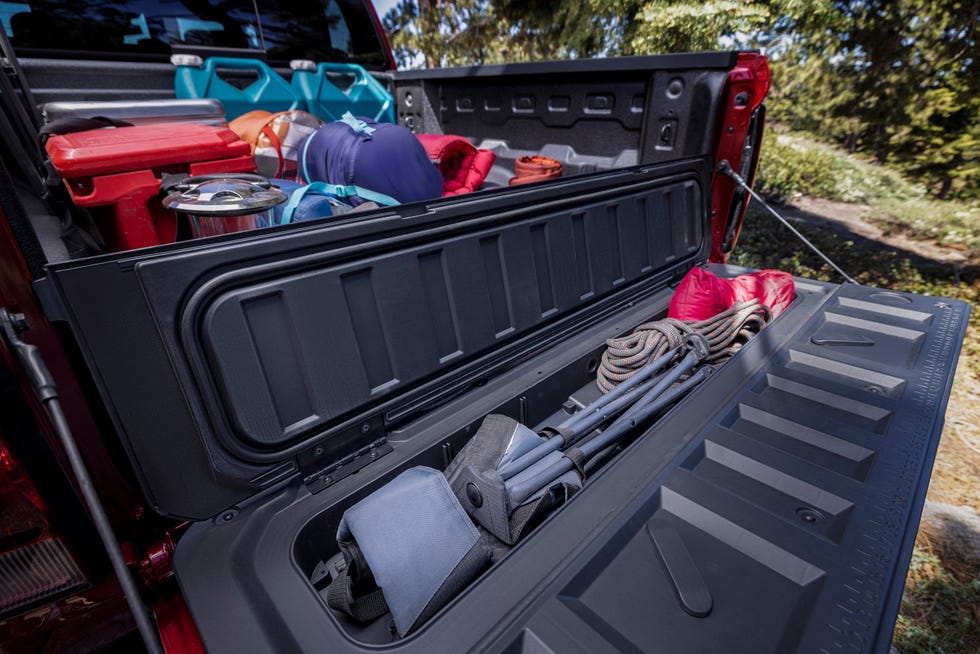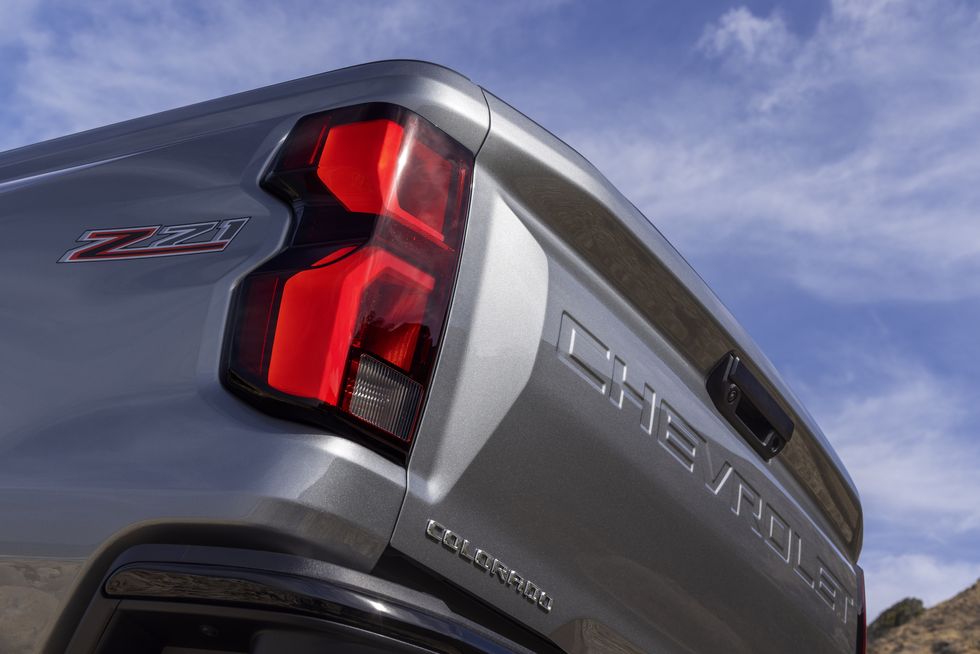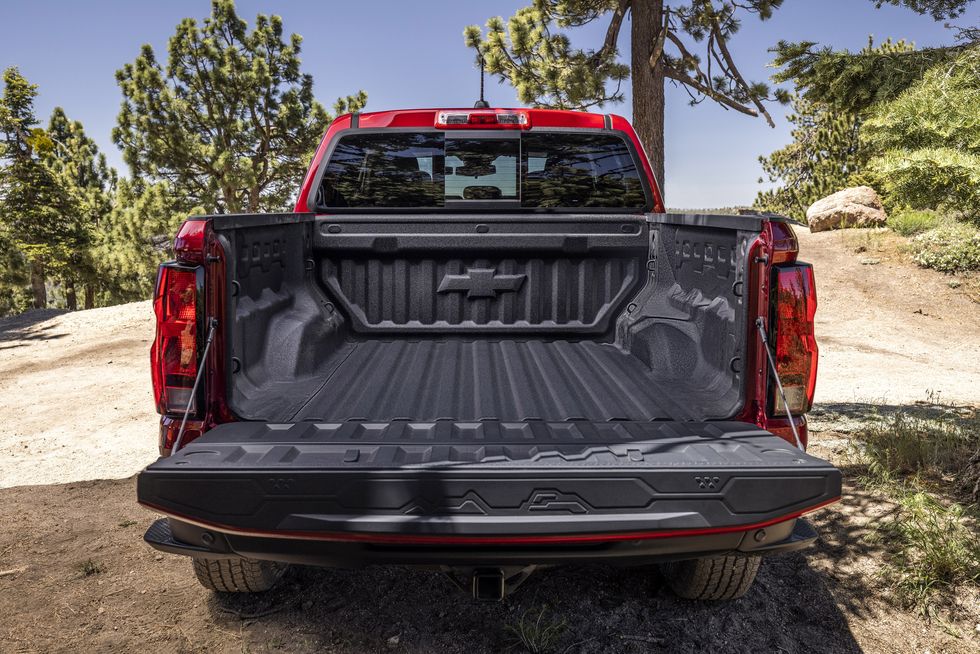There’s no denying the 2023 Chevrolet Colorado has received an extreme makeover that has considerably toughened its image, with a bold front end and creased chiseled flanks. The new third-generation example stands in stark contrast to the outgoing unit, which came across as little more than a scaled-down full-size truck. It failed to take advantage of its smaller size in a mid-size segment that was being increasingly defined by perceived toughness and off-road prowess. Thus far, the Toyota Tacoma has owned that territory, but the Colorado looks set to mount a serious challenge.
That’s because the changes are also functional and go beyond mere styling. The truck’s reworked air dam and shorter front overhang result in a healthy 29.1-degree approach angle for the Z71, which formerly had a low-hanging and difficult-to-remove spoiler that would barely clear a parking block, let alone any off-highway obstacle worth the name. The prior Z71 “off-road” model couldn’t even clear a 20.0-degree Ramp Travel Index ramp, earning it a score of zero.
Out back, the spare has been tucked up some 2.5 inches higher for better departure clearance, because there’s no longer a need to create space for the discontinued diesel engine’s DEF tank. It’s easy to see the terrain in front because of the way the hood creases are shaped, and the lower rear shock mounts are less vulnerable to impact because they have been shifted closer to the rear springs. In other words, a Z71 can now readily head off-pavement, and the WT (work truck) and LT trims are better able to maneuver a job site or pole-line road.
Chevrolet’s engineering team didn’t stop there. The new Trail Boss is a budget-minded off-roader that slots in below the ZR2 while outperforming and costing less than a Z71. It combines 32-inch all-terrain tires, flared fenders, and nearly the same wide stance as the ZR2 with a 2.0-inch lift that’s more than just cosmetic. Compared to the WT, LT, and Z71, the Trail Boss sports 1.5 inches of extra front suspension travel and an extra 1.0 inch out back, enough to make a difference in the wild, not to mention on our RTI ramp. Its longer shocks are still twin-tube units, and it shares its rear limited-slip differential with the Z71. If you want Multimatic spool-valve dampers and lockable front and rear diffs, the not-yet-released ZR2 has those, plus a taller lift and even more rear suspension travel.
Besides the move toward off-road legitimacy, another theme defines the new Colorado: simplification. There’s just one cab and bed choice this time, a crew cab with a five-foot-two-inch bed. That’s the most popular configuration by a ridiculously wide margin, so the loss of variety in the cab/bed realm isn’t liable to put off many buyers. Chevrolet has made a move to assuage those who might pine for a longer bed, adding an optional mid-level tailgate stop that aligns its upper edge up with the inner fender bulges to fashion a level base for hauling plywood or drywall.
The engine lineup has likewise been streamlined. The 2.5-liter inline-four, 2.8-liter inline-four turbo-diesel, and 3.6-liter V-6 are history, replaced here by a turbocharged 2.7-liter inline-four gas engine across the board, albeit in three flavors. All are backed by an eight-speed automatic, and four-wheel-drive versions (optional on WT and LT and the sole configuration on the others) have an automatic four-wheel-drive engagement setting and 2.72:1 low-range gearing. No fuel-economy figures are available for its three guises, but one is allegedly more fuel efficient than the 2.5-liter four, two are more powerful than the V-6, and the top dog makes more torque than the diesel.
A somewhat decontented 2.7 Turbo base version comes standard in the WT and LT, where it makes 237 horsepower, 259 pound-feet of torque and supports a 3500-pound tow rating. The 2.7 Turbo Plus is optional in those trucks and standard in Z71 and Trail Boss, and it’s good for 310 horses, 390 pound-feet, and 7700 pounds of tow capacity, which ties the Jeep Gladiator for best in class. The ZR2 gets the 2.7 Turbo HO (high output), with the same horsepower as the Plus but with 430 pound-feet of torque; that’s due to a software reflash, not mechanical differences. The best part: Turbo Plus owners can pay a dealer for the HO calibration upon delivery or anytime after purchase.
Our ZR2 drive will come later, but we sampled all the others. On pavement, all four shared a common trait: Their suspensions readily soak up irregular pavement without excess residual shake, and they are adept at gliding over coarse road surfaces. They feel smooth and well put together, the exception being the occasional rear kick any unloaded truck can produce when driven over the wrong sort of bump. All of them are similarly pleasing to wheel around town because they steer smoothly and exhibit a good sense of straight-ahead, with the 17-inch tire fitted to the WT a surprising standout.
The base engine produces sufficient beans for an economy-minded powertrain, possibly owing to its low torque peak of 1250 rpm. It does sound a bit gravelly, though, in contrast to the 2.7 Turbo Plus, which is much less coarse while being perfectly capable of moving the heavier Z71 and Trail Boss with little apparent effort. We tend to prefer eight-speed automatics over the competition’s 10-speed units, and that was indeed the case here. But there’s no sport mode among the drive settings, which include Normal, Tow/Haul, Off-Road, and Terrain.
Off pavement, the Z71 and Trail Boss are impressive. Their suspensions absorbed rough terrain without passing any noise or undamped shake into the drum-tight cabin, and their limited-slip rear differentials maintained forward progress even with one rear wheel hiked high in the air through a diagonal ditch. The highlight may have been the brakes, which are linear and firm in normal use due to the use of an electronic booster instead of a vacuum unit.
With the mode dial in Terrain, this booster supports a smooth one-pedal driving mode, the speed range of which you can tailor by setting the shift lever to L and tweaking the manual shift button. Unlike competing systems, the Colorado’s setup is utterly free of any ABS pulsing and feels like one-pedal driving in an EV, with delicate control that let us tiptoe down into dips and out the other side without ever thinking of touching the actual brake pedal. Don’t like the idea? Select Off-Road mode instead, and normal service resumes.
The simplification theme continues inside, where all Colorado trims from WT on up get a keyless ignition—actually great for off-roading because there are no jangling keys. A large 11.3-inch touchscreen is also standard, and it supports wireless smartphone integration and Google Built-In, which is a bit of a laugh considering the latter only comes on the new Honda Accord’s high-zoot Touring trim.
But simplification also brings a few quirks. The window lock button is on the touchscreen, as are the headlight controls (although the latter has an always-visible access icon). Perhaps that’s okay? Window lock isn’t something we toggle much, and the headlights are so comprehensively auto-controlled as to come on at dusk or whenever the wipers are running. But the least appealing aspect may be the interior materials, which are generally plasticky with an unconvincing grain that’s a bit too glossy. The Trail Boss keeps its price low by being based on the WT, so its interior is equally underwhelming. But even the Z71, the most luxurious, features a soft-touch dash and armrest treatment of a mysterious rubbery origin.
Pricing has edged up, but not to an alarming degree—especially when considering the numerous improvements. A two-wheel-drive WT goes for $30,695, which is barely $1000 more than before. A four-wheel-drive WT starts at $33,995, which is $300 less than before. The Z71 goes for $41,395, only $900 more than last year. As for the Trail Boss, it starts at a very reasonable $38,495. The ZR2, which we’ll sample in a couple months, will command close to a $10K premium at $48,295.
In many ways, the appeal of the new Chevrolet Colorado has risen to an all-time high. It has made the jump from pint-size pickup that didn’t know what it wanted to be in life to a more self-assured truck that should appeal to the outdoor lifestyle buyers who have traditionally gravitated to the Tacoma. Will it pan out that way? We’ll know for certain when the new Tacoma and Ford Ranger surface in the coming months. This is going to get interesting.
Specifications
Specifications
2023 Chevrolet Colorado
Vehicle Type: front-engine, rear- or rear/4-wheel-drive, 5-passenger, 4-door pickup
PRICE
Base: WT 4×2, $30,695; LT 4×2, $33,095; WT 4×4, $33,995; LT 4×4, $36,395; Trail Boss, $38,495; Z71, $41,395
ENGINES
turbocharged and intercooled DOHC 16-valve 2.7-liter inline-4, 237 or 310 hp, 259 or 390 lb-ft
TRANSMISSION
8-speed automatic
DIMENSIONS
Wheelbase: 131.4 in
Length: 212.7-213.2 in
Width: 74.9-76.3 in
Height: 70.7-71.9 in
Passenger Volume, F/R: 58/43 ft3
Curb Weight (C/D est): 4300-4700 lb
PERFORMANCE (C/D EST)
60 mph: 6.0-7.2 sec
1/4-Mile: 14.7-15.9 sec
Top Speed: 100 mph
EPA FUEL ECONOMY (C/D EST)
Combined/City/Highway: 20-23/17-20/24-26 mpg




